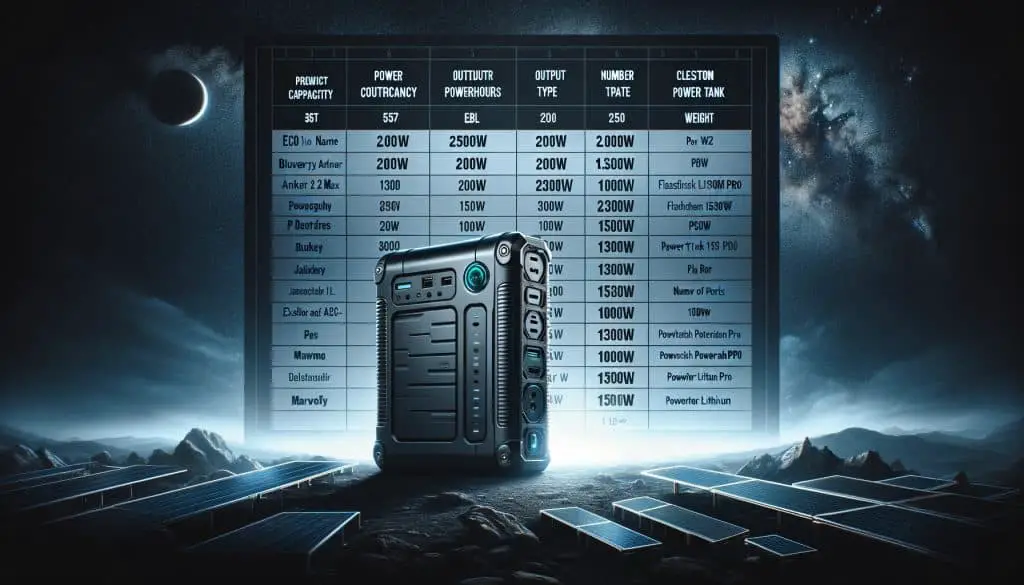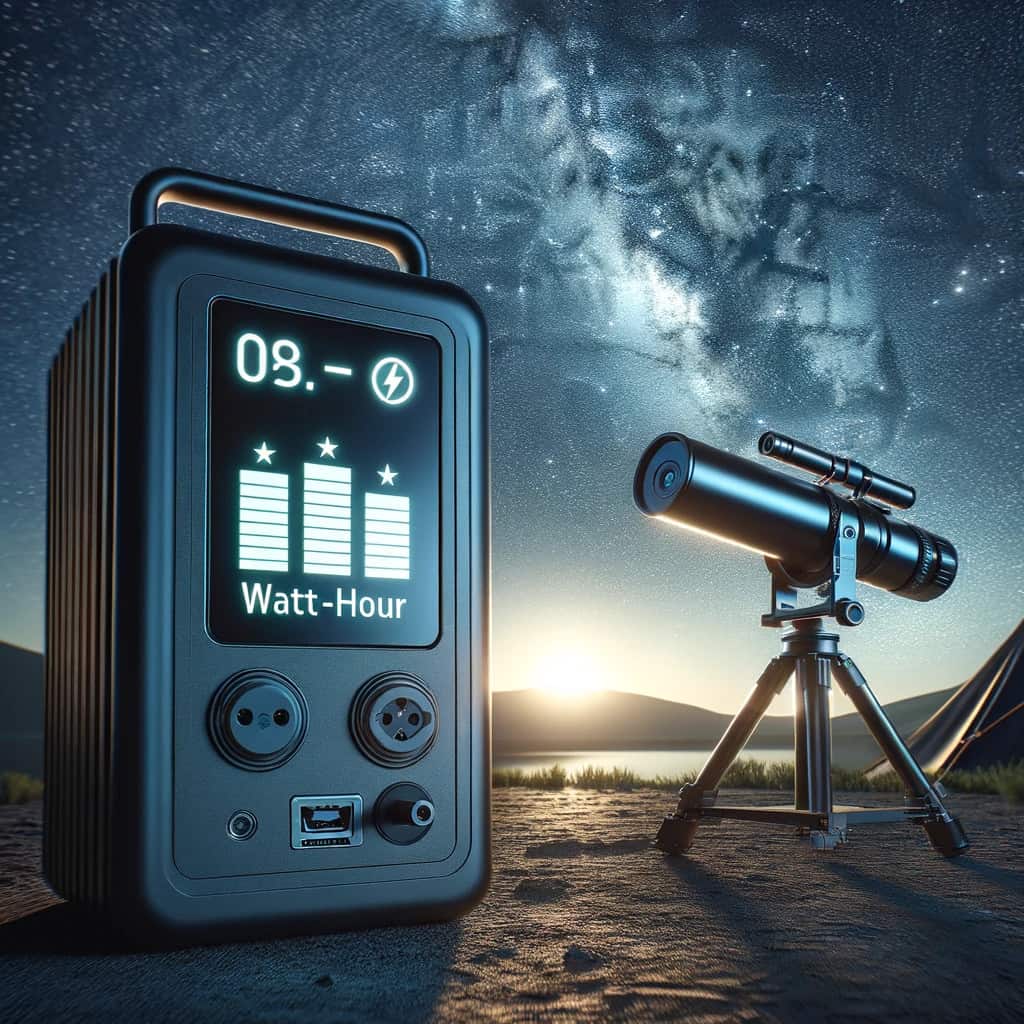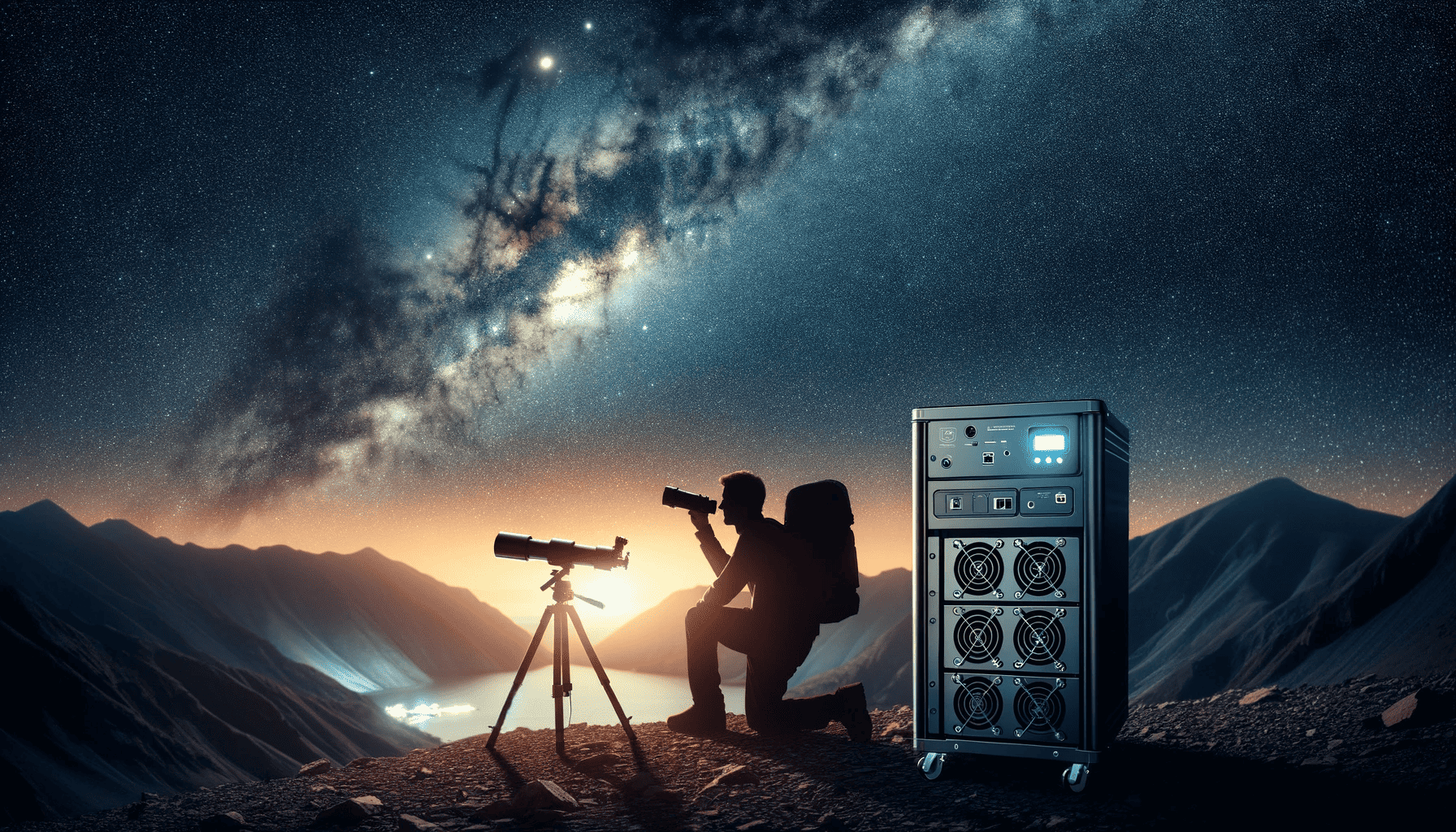Astrophotography, a dance with the stars, demands not just skill and patience but also the right gear. And what’s more crucial than a Portable Power Station when you’re capturing the cosmos? Imagine this: you’re under the velvety dark sky, your telescope aimed at the Milky Way, camera set, but wait – what powers this magic? Yes, the silent, steady heartbeat of your setup – the power station.
Picture this scenario: You, an avid astrophotographer, venture to a remote, dark sky spot. Your gear is top-notch – a dedicated astronomy camera, equatorial telescope mount, and the little essentials like dew heater bands and an autofocuser. But here’s the catch – you need power, a lot of it, and for a long time.
This is where battery life, power output, and output ports become your best friends. You remember exploring options like the robust Anker 757 PowerHouse or the lightweight Jackery Explorer 500, balancing budget and weight considerations.
Now, add a twist. You’re a DIY enthusiast. The thought of building your own power station with deep cycle marine batteries and an inverter sends a t ill down your spine. Or maybe, you lean towards eco-friendly solutions like solar panels.
Choices like the Bluetti EB3A or the Togo Power Advance 350 come to mind, each with their unique features catering to different needs. And for the brand loyalists, there’s always the reliable Celestron PowerTank models or the versatile BLUETTI and AIMTOM units.
In the world of astrophotography, the right portable power station isn’t just an accessory; it’s a lifeline. Whether you’re a novice stargazer or a seasoned astro-photographer, the quest for the perfect power source is an adventure in itself. And I’m here to guide you t ough this electrifying journey. Let’s dive in and discover the power station that’ll make your starry nights unforgettable!
Top 10 Portable Power Stations for Astrophotography
| EcoFlow Delta 2 Max | Anker 767 PowerHouse |
|---|---|
| Power Capacity: 2016Wh | Power Capacity: 1229Wh |
| Output: Pure sine wave | Output: Pure sine wave |
| Portability: Lightweight and portable | Portability: Lightweight and portable |
| Ideal for: Multiple devices, hours of power | Ideal for: Most equipment, several hours |
| BLUETTI AC200P | Jackery Explorer 1000 Pro |
|---|---|
| Power Capacity: 2000Wh | Power Capacity: 1002Wh |
| Output: Pure sine wave | Output: Pure sine wave |
| Portability: Lightweight and portable | Portability: Lightweight and portable |
| Ideal for: Variety of devices | Ideal for: Popular choice for photographers |
| Powkey 1000W Portable Power Station | EBL 1500W Portable Power Station |
|---|---|
| Power Capacity: 1000Wh | Power Capacity: 1500Wh |
| Output: Pure sine wave | Output: Pure sine wave |
| Portability: Lightweight and portable | Portability: Lightweight and portable |
| Ideal for: Budget-friendly option | Ideal for: Good mid-range option |
| MARBERO 1500W Portable Power Station | FlashFish P300S |
|---|---|
| Power Capacity: 1500Wh | Power Capacity: 300Wh |
| Output: Pure sine wave | Output: Pure sine wave |
| Portability: Lightweight and portable | Portability: Lightweight and portable |
| Ideal for: Good mid-range option | Ideal for: Budget-friendly, smaller size |
| AIMTOM 1500W Portable Power Station | Celestron PowerTank Lithium Pro |
|---|---|
| Power Capacity: 1500Wh | Power Capacity: 780Wh |
| Output: Pure sine wave | Output: Pure sine wave |
| Portability: Lightweight and portable | Portability: Lightweight and portable |
| Ideal for: Powerful and versatile | Ideal for: Designed for astrophotography |
Here’s what to look for when choosing the best portable power station for your astrophotography adventures:
- Power Capacity: This is the heart of a portable power station. You’ll want a unit that can store enough energy to last t ough your entire session, which can sometimes be all night. Look for high-capacity batteries measured in watt-hours (Wh) to keep your devices running without interruption.
- Pure Sine Wave Output: Many advanced cameras and sensitive electronic devices require a pure sine wave for optimal performance. This mimics the clean, stable electricity you’d get from a household outlet, reducing the risk of damaging delicate equipment.
- Multiple Output Ports: Astrophotography setups often involve several devices simultaneously, such as cameras, laptops, and mount controls. A power station with a variety of output ports, including USB, AC, and DC, gives you the flexibility to power multiple devices at once.
- Portability and Weight: Since astrophotography often takes you off the beaten path, a power station’s size and weight are crucial. It should be compact enough to carry to remote locations but sturdy enough to withstand outdoor conditions.
Selecting the right portable power station can make the difference between a successful night of capturing the cosmos and a trip cut short by power issues. Keep these features in mind, and you’ll be well-equipped to power your journey t ough the stars.

Understanding Astrophotography and Power Needs
Astrophotography is an enchanting pursuit that combines the intricacies of photography with the awe-inspiring subjects of the night sky.
It’s a specialized field of photography focusing on capturing images of celestial events, constellations, planets, and deep-sky objects like galaxies and nebulae. To the astrophotographer, the camera is a window to the universe, revealing wonders invisible to the naked eye.

The need for reliable power in astrophotography cannot be overstressed.
As the majority of astrophotography takes place in remote locations to escape light pollution, access to a stable power source is non-existent.
Night-time photography sessions also typically last several hours, often running the whole night to capture the perfect shot or to conduct time-lapse photography. Without a consistent and reliable power supply, the cameras, tracking mounts, computers, and other auxiliary equipment cannot function, rendering a photography session unsuccessful.
Power capacity is the lifeline of an astrophotography setup.
It’s measured in watt-hours (Wh) and indicates the total amount of energy a power station can store. This capacity determines how long you can operate your equipment on a single charge.
For astrophotography, where sessions can be lengthy, a higher capacity means you can shoot longer without worrying about your equipment shutting down mid-session. It’s not just about having enough power; it’s about having a buffer for the unexpected, ensuring that you never miss that critical shot due to a power outage.
Pure sine wave output is another critical aspect of the power used in astrophotography.
This refers to the type of electrical current that a power station provides. A pure sine wave is smooth and consistent, resembling the power supplied by standard electrical grids. Sensitive astrophotography equipment, especially advanced CCD cameras and computers, may require this type of power to operate correctly and safely.
Devices running on pure sine wave power are less prone to electrical noise, which can cause disruptions and damage to delicate electronic circuits.
< class="wp-block-separator has-alpha-channel-opacity"/>Evaluating Portable Power Stations
When evaluating portable power stations for astrophotography, there are several criteria that should guide your choice to ensure that your celestial photography sessions are powered efficiently t oughout the night.

Also see: Good Portable Power Stations with Multiple Charging Options
Capacity and Output: The first criterion is the capacity, as mentioned earlier, which must match the energy demands of all your equipment. Look for a power station with a watt-hour rating that exceeds your total expected usage, keeping in mind the duration of your astrophotography sessions.
Pure Sine Wave Output: Ensure that the power station offers a pure sine wave output. This is non-negotiable for astrophotographers who use sensitive equipment. The pure sine wave ensures that your equipment operates correctly and the power supply does not introduce any electrical noise into your system.
Multiple Output Ports: Astrophotography typically involves several pieces of equipment running simultaneously. Therefore, multiple output ports are a must.
A good power station should offer a variety of USB, DC, and AC outlets, allowing you to power cameras, laptops, mount tracking systems, and other accessories all at once. This versatility is key in making a power station suitable for astrophotography.
Portability and Weight: Field use is a significant part of astrophotography, often requiring travel to remote locations. The power station you choose should strike a balance between capacity and portability.
It should be lightweight enough to carry comfortably but robust enough to hold a charge for all your equipment. Features like carrying handles, rugged design, and a compact form factor can significantly enhance portability.
Durability and Build Quality: Since astrophotography equipment is often used in the great outdoors, the power station should be able to withstand the rigors of field use. A durable build that can handle a bit of rough treatment is essential.
< class="wp-block-separator has-alpha-channel-opacity"/>Choosing the Right Power Station for Your Astrophotography Style
Choosing the right portable power station for astrophotography is essential because it can vary dramatically based on your photography style and experience level. Here’s a guide to help you decide:

For Stationary Astrophotographers:
- If you typically set up in one spot and don’t move much, go for power stations with higher capacity and more ports.
- Example: The EcoFlow Delta 2 Max offers ample power and multiple ports, making it ideal for powering several devices over a long night.
For Astrophotographers Who Trek:
- Prioritize lightweight and compact power stations.
- Example: The Jackery Explorer 500 is a balance of decent power capacity and portability, suitable for those who hike to their photography spots.
For Beginners:
- Choose user-friendly power stations with enough power for basic setups.
- Example: The Anker 767 PowerHouse, while advanced, is also intuitive and can grow with your skill set and gear collection.
For Experienced Astrophotographers:
- Opt for power stations that offer advanced features like solar panel compatibility and fast charging.
- Example: The Goal Zero Yeti 1500X is robust and feature-rich, ideal for experienced photographers with more demanding power needs.
Remember, the best power station for you is one that not only suits your current needs but also has the potential to accommodate your growing interest and expertise in astrophotography.
< class="wp-block-separator has-alpha-channel-opacity"/>Conclusion
In wrapping up, we’ve delved into the essentials of astrophotography and the critical role portable power stations play in the pursuit of capturing the night sky. It’s clear that a reliable power source is as crucial as the camera itself.

Also see: 10 Good Portable Power Stations for Gamers
When choosing a power station, consider the power capacity for those long exposure shots, pure sine wave output for protecting sensitive equipment, the convenience of multiple ports, and the all-important factor of portability.
From the robust EcoFlow Delta 2 Max to the compact Jackery Explorer 500, each power station has its unique advantages to offer. Whether you’re just starting out or are a seasoned stargazer, there’s a power solution out there to suit your style.
And for those who wander off the beaten path to find the perfect shot, lightweight options ensure your gear doesn’t weigh you down.
As you gear up to explore the cosmos t ough your lens, remember that the best portable power station is the one that meets your specific needs, allows for uninterrupted shooting, and grows with your passion for astrophotography.
With the right equipment, the wonders of the night sky are yours to capture. So, go ahead and power up—adventure and stellar masterpieces await.
< class="wp-block-separator has-alpha-channel-opacity"/>Glossary of Terms

Astrophotography: This is taking photos of the stars, planets, and other celestial objects. Think of it as landscape photography in the night sky.
Portable Power Station: A big battery that you can carry around. It’s like a power bank for your phone, but bigger and can power cameras and laptops.
Power Capacity: It tells you how much electricity the power station can store. Imagine a water tank; the capacity is how much water it can hold.
Pure Sine Wave Output: This is a type of electricity flow that’s smooth and steady, just like what you get from wall outlets. It’s important for sensitive gadgets, so they run smoothly without glitches.
Multiple Ports: These are the different spots on the power station where you can plug in your devices. It’s like having many sockets to charge more than one thing at a time.
Portability: It’s about how easy it is to carry the power station around. If it’s light and compact, it’s portable.

Exposure: In photography, this is how long your camera’s sensor is open to light. In astrophotography, longer exposure means more starlight can be captured.
Long Exposure Shots: These are photos where the camera takes longer to capture an image to let in more light. It’s like opening your eyes in a dark room and waiting to see more clearly.
Lightweight Options: These are power stations that are easy to carry because they don’t weigh much. Perfect for long hikes under the stars.
Lens: The part of the camera that focuses light to take a picture. In astrophotography, the lens decides how much of the sky you can capture.
Celestial Objects: These are things in space like stars, planets, and moons.
Stellar Masterpieces: Fancy way of saying awesome space photos.
Understanding these terms can help you get started in astrophotography and choose the right gear, especially the portable power station that keeps your equipment running while you capture the sky's beauty.< class="wp-block-separator has-alpha-channel-opacity"/>
FAQ Section

Q: How long can a portable power station run my astrophotography equipment?
A: It depends on the power station’s capacity and your equipment’s power needs. Typically, a good station can run a camera setup all night. Check the equipment’s power usage and compare it with the power station’s capacity listed in the specs.
Q: Can I use a portable power station for devices other than cameras?
A: Absolutely. You can power laptops, charge phones, or run other gadgets needed for your night-time photography session.
Q: Do portable power stations handle the cold weather during night photography?
A: Yes, most are built to operate in a range of temperatures. However, extreme cold can affect performance, so it’s wise to check the temperature limits in the product details.
Q: What’s the benefit of having multiple output ports on a power station?
A: Multiple ports let you charge different devices simultaneously, like your camera, phone, and a laptop. This saves time and ensures all your gear is powered up. For more info, see the section on Evaluating Portable Power Stations.
Q: Why is pure sine wave output important for astrophotography?
A: Pure sine wave ensures your sensitive photography equipment operates correctly without any electrical interference or damage. More on this in Understanding Astrophotography and Power Needs.
Q: How do I know if a power station is portable enough for my field trips?
A: Check the weight and dimensions. A lighter and compact power station is considered portable. Our section on Evaluating Portable Power Stations has more details.
Q: Are portable power stations safe to use with expensive astrophotography equipment?
A: Yes, they’re designed to be safe. Look for features like surge protection and overcharge protection to ensure safety. See Detailed Reviews of Each Power Station for safety features of specific models.
Q: Can I take a portable power station on a plane?
A: It depends on its battery size and airline regulations. Generally, batteries under 100Wh are acceptable, but always check with your airline first.

